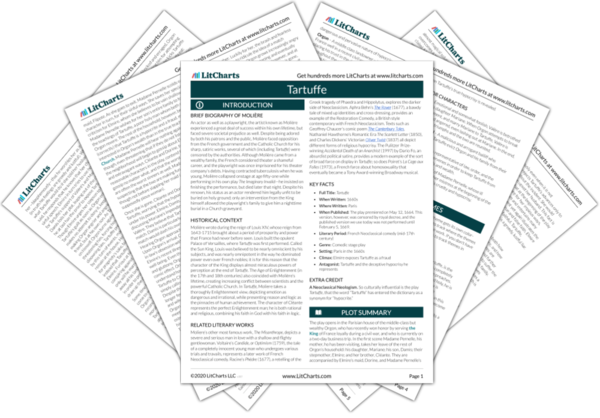Hypocrisy
The title character of this work, Tartuffe, is the ultimate hypocrite: his sinful actions completely contradict the Catholic values that he preaches. Although Tartuffe claims to be pious, charitable, and holy, he is in fact lustful, greedy, and treacherous. His hypocrisy is infectious and dangerous, destabilizing Orgon’s entire household and negatively impacting those who believe in this supposedly pious man. In fact, those who trust Tartuffe become hypocrites themselves. Madame Pernelle, who preaches…
read analysis of HypocrisyReason vs. Emotion
The people of Moliere’s society considered reason one of the highest of virtues, and considered emotion weak and irrational. Throughout the play, Tartuffe uses emotion to deceive those around him, while Cléante, Dorine, and Elmire employ reason to combat him. The contrast between the emotion of Tartuffe and the reason of the other characters clearly illustrates the differences between them. Meanwhile Orgon, the primary target of Tartuffe’s seductive arguments, becomes increasingly swayed…
read analysis of Reason vs. EmotionReligion, Piety, and Morals
French culture at this time closely linked society and religion; the Church held an enormous amount of power, and piety was considered an essential part of everyday life. Tartuffe, however, misuses religion, his shows of faith contrasting with the quiet but true faith of characters such as Elmire. Though Tartuffe has become a symbol of religious hypocrisy, the play does not condemn religion; rather, Moliere seeks to illustrate the difficulty of discerning the…
read analysis of Religion, Piety, and Morals
Family and Fathers
In Tartuffe, Moliere demonstrates both how important family and fatherhood are, and how devastating it is when these structures are corrupted. As Orgon, the patriarch, falls further and further into Tartuffe’s trap, all those in his household begin to suffer the consequences, making clear his central role within his family. This truth contradicts Orgon’s own fear that his relatives consider him laughable and irrelevant. Although he makes a series of misguided choices—the first…
read analysis of Family and FathersAppearances and Beauty
Throughout Tartuffe, Moliere illustrates that appearances can be deceiving. Yet at the same time, he does not condemn that most shallow of virtues, beauty. Rather, Moliere contests that beauty is something to be appreciated and admired, but that it cannot rule our actions. At the beginning of the play, Elmire seems a beautiful, thoughtless flirt. The rigid Madame Pernelle condemns her son’s wife for entertaining too many callers, and caring too much about her…
read analysis of Appearances and Beauty






